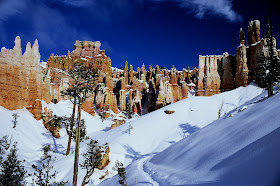We’re snowshoeing inside a giant layer cake with dollops of fluffy white frosting perched on pinnacles, sandwiched between rock layers, and sliding down canyon walls. Where is this confectionary dreamland? Along the Queens Garden Trail in Bryce Canyon National Park.
In his book 50 Best Short Hikes in Utah’s National Parks Ron Adkison describes the Queens Garden Trail:
“This is a popular dayhike into the incomparable Bryce Canyon amphitheater, descending into the realm of hoodoos, castles, and balanced rocks, many of which have been likened to familiar images and given such fanciful names as Gullivers Castle and Queen Victoria.”
This is an apt and succinct description of the delights offered by this trail and I would add this: When viewed through the lens of a heavy snowfall, the charms of this trail are multiplied exponentially.
Although Bryce Canyon is enchanting in any season I prefer a January or February visit. After viewing the following photographs, I think you’ll agree.
As always, click on an image to enlarge.
As always, click on an image to enlarge.
 |
| Strapping on snowshoes for the Queens Garden hike. |
 |
| Rita, approaching one of the tunnels on the Queens Garden Trail. |
 |
| If this isn't a day in paradise, then I don't know what is. |
 |
| Inside the layer cake. |
 |
| Captivating views along the trail. |
 |
| Our group descends into the amphitheater. |
 |
| Tim poses among icing-topped red rocks. |
Go ahead, immerse yourself in the marshmallow world that is Bryce Canyon in winter.
Plan your visit to Bryce Canyon National Park by visiting these websites: http://www.nps.gov/brca/index.htm



















